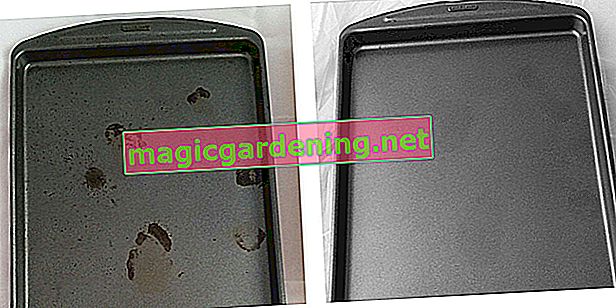
Pre-clean the chanterelles you have collected yourself in the forest
You should pre-sort the mushrooms you find in the forest - and sort out the false chanterelle right away, because a single specimen can spoil an entire dish! - and rough plaster. It is best to leave specimens that already look very ugly, for example very dark and / or already have a rubbery consistency, in the forest. These can no longer be used for consumption. You don't even take very large specimens home with you. It is basically not necessary to cut the length of the mushrooms, as is the case with boletus and other tubular mushrooms, since chanterelles are rarely attacked by maggots. However, you should remove the coarsest dirt and any eaten or other damaged areas.
also read
- How to clean chanterelles properly
- How to keep chanterelles - the best tips and tricks
- Clean the oyster mushrooms dry and do not wash them
Roughly clean and wash the chanterelles - this is how it works
When you get home, clean the chanterelles straight away. Like all mushrooms, they only last for a short time and should therefore be processed immediately. Pick up the small mushrooms one by one and cut off the lower piece of the stem. You check the hat carefully with a small knife and carefully scrape off dirt and any forest residues. Then briefly put the mushrooms in a water bath:
- Fill a bowl with fresh, cold water.
- Put the mushrooms inside.
- Gently wash them by submerging them in the water.
- Check whether there is still dirt on the mushrooms.
- Then take the mushrooms out of the water with a slotted spoon.
- Put the chanterelles in a colander and let them drain.
- Then dry them well in a clean kitchen towel.
Instead of bathing the mushrooms, you can also put them in a sieve and rinse them off vigorously with a hand shower. Regardless of how you wash the chanterelles: The mushrooms should only come into contact with the water for a few seconds. Otherwise, they quickly soak up the damp water and later get an unpleasant gummy consistency when roasting, not to mention the loss of aroma and taste. Perhaps you have also heard or read that mushrooms should generally not be washed: this is basically correct. On the other hand, chanterelles are very dirty - as they are hidden deep in the moss - and can only be cleaned thoroughly by washing.
Then prepare or preserve fresh chanterelles
After cleaning and washing, you can blanch the chanterelles and then freeze them. The small mushrooms can also be frozen raw, but then often turn bitter. If they are to be used immediately, they taste best when they are simply prepared: Fry the finely diced onions in bacon in a pan. Add the raw (not blanched!) Or frozen chanterelles as well as a strong dash of cream and a teaspoon of sauce stock. Let the sauce boil briefly and then simmer for about ten minutes.
Classic kitchen trick: brush the chanterelles with flour
Since a lot of dirt that is difficult to remove often sticks to chanterelles, you can also use this old kitchen trick to get the mushrooms clean.
Required materials:
- fresh chanterelles
- a sieve
- Flour (type 405 is sufficient!)
- a big spoon
- a freezer bag
- and paper towels
How to clean the chanterelles with flour:
Place the chanterelles to be cleaned in the freezer bag and add one to two tablespoons of flour. Close the bag - bags with a zipper are particularly useful for this purpose - and shake the flour evenly until all the mushrooms are covered with a thin white layer. Put the floured mushrooms in the sieve and rinse off the flour and dirt with cold water. Since the dirt sticks to the flour, it is removed at the same time. Let the mushrooms drain well on some kitchen paper.
Tips
Instead of washing the chanterelles, you can tackle stubborn dirt with just a dampened kitchen towel. This has the advantage that the mushrooms don't soak up as much water - washed chanterelles are always clean, but they also drain a lot of water when roasting and are therefore more likely to stew in their own juice. Washing is therefore only useful if you want to prepare the mushrooms with a sauce.








